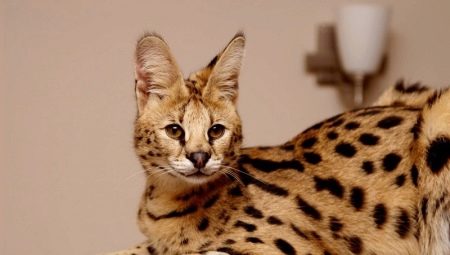For many years, pets are not only loved and funny animals that bring a huge amount of positive emotions and joy, but also an indicator of the financial level. Representatives of the wealthy strata of the population have very rare and expensive pets who can emphasize their material well-being. In exotic living corners of private mansions, you can often find unusual birds, animals and reptiles.
A spectacular and expensive purchase will be a serval - a domesticated wild cat. A spotted large animal will look expressively in the leather interior of an elite car or on a Persian carpet in the living room.
Origin history
African Serval is a wild animal whose color resembles a cheetah. The birthplace of this beast is the tropical forests of Africa. In the natural habitat, biologists count more than 10 subspecies of cats of this breed. The bright color of the fur and its high cost led to a significant reduction in the number of individuals in the natural habitat zone. In pursuit of profit, poachers began to massively capture and exterminate not only adult cats, but also kittens.
For a long time, the serval was considered an exclusively wild animal, which is not amenable to domestication and training. Professional breeders have denied this fact and were able to tame a wild cat.
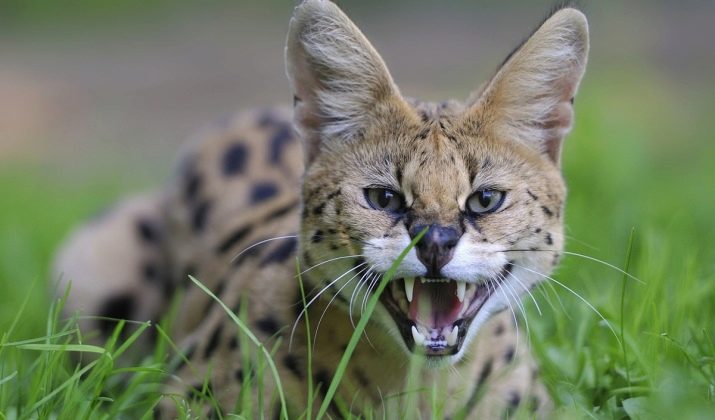
Description
Serval is a graceful cat that even at home preserves the habits of a predator and looks like a cheetah. The cat of the breed served a small head, protruding auricles, which on the outside have black and white stripes.The area of the nose and nose is massive and large. The mustache is long and stiff. Almond-shaped eyes below and in the form of a boomerang on top.
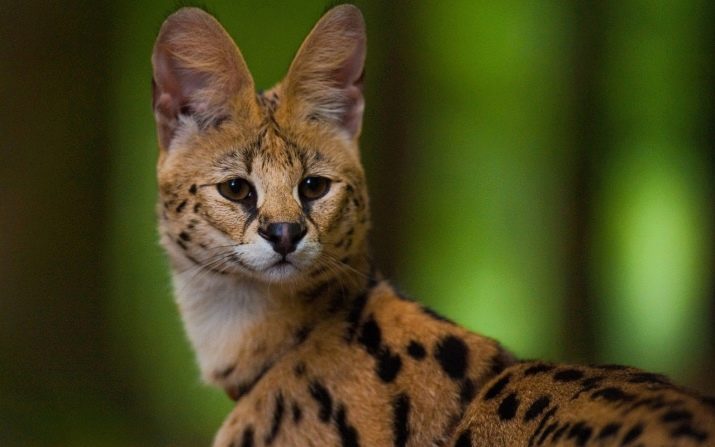
Powerful long fangs, the length of which can reach 30 mm, are located in a large wide mouth.
The average length of a powerful fleshy tail is 35 cm. The paws are long, thin and graceful. The maximum body size of an adult can reach 1 m, and the weight can reach 17 kg.
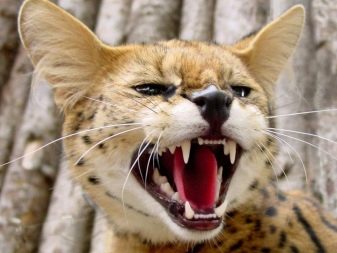
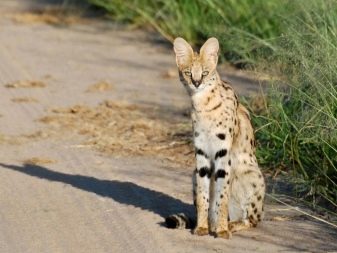
A distinctive feature of animals is a bright unusual color. Black spots are located on the sandy or saturated brown body, which smoothly pass in the back zone into solid lines. On the chest and abdomen, the coat acquires a white tone. The delicate fur has a smooth uniform structure with very short villi.

Serval has a sensitive hearing and lightning reaction. The life span of the beast at home can reach 20 years. Like any animal, the African serval has a number of advantages and disadvantages. Advantages:
- high esthetic indicators;
- long period of life;
- lack of unmotivated aggression and inappropriate behavior;
- avoiding conflict situations;
- dog devotion and love for the owner;
- playfulness and sociability;
- high intellectual abilities;
- tendency to train;
- the absence of conflicts with equal animals;
- good immunity and resistance to various diseases;
- unpretentiousness to care and maintenance.

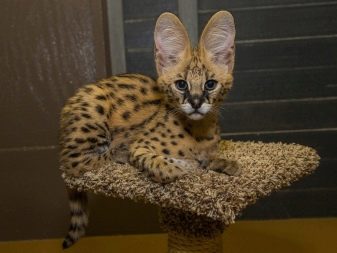
Disadvantages:
- cunning and stubbornness;
- high price range;
- incompatibility with small children;
- aggressive attitude towards small pets;
- excessive activity and constant desire to jump;
- the need for education and training;
- the presence of a constant desire to bite and tag everything;
- the need for a large room;
- intolerance to screaming and rude attitude;
- high cost of the diet;
- need for daily street walks;
- difficulty in acquiring.
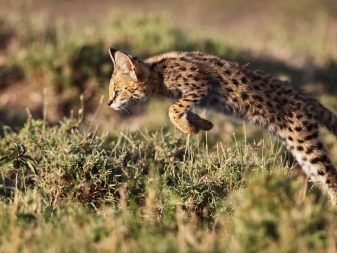

Where does it live?
The African cat is a resident of the tropical regions of Africa, the Sahara, Morroco and Algeria. Animals negatively relate to open areas and prefer bushes and grassy bushes near ponds and rivers. To move the serval uses the edges and open areas, hunts in the morning and evening hours.
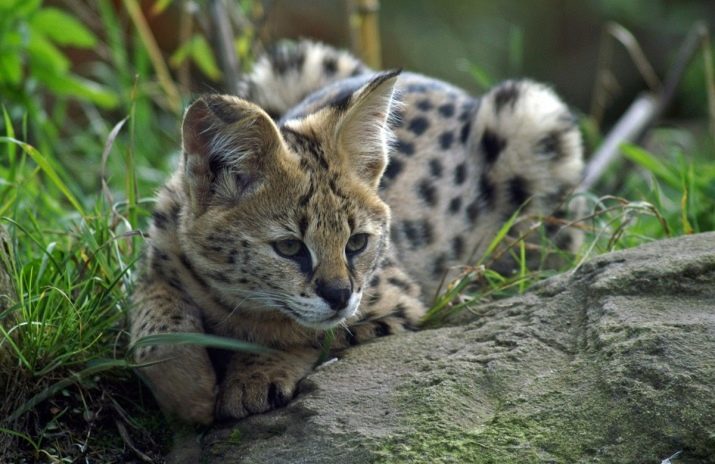
To feed cats catch rodents, birds, reptiles and large insects. For hunting birds, the animal uses instant vertical jumps. To catch rodents, the cat simply digs out the prey habitat and extracts it from there.
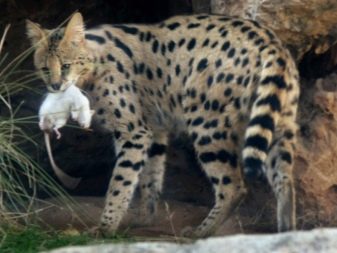

Serval is a solitary animal that lives and hunts on its own. Rapprochement with relatives occurs only during the mating season. Between males, it is very rare to see a struggle for territory. Each animal is on its own site and does not pretend to be an additional area. In the natural habitat, the most dangerous for the serval are hyenas, wild dogs and leopards.
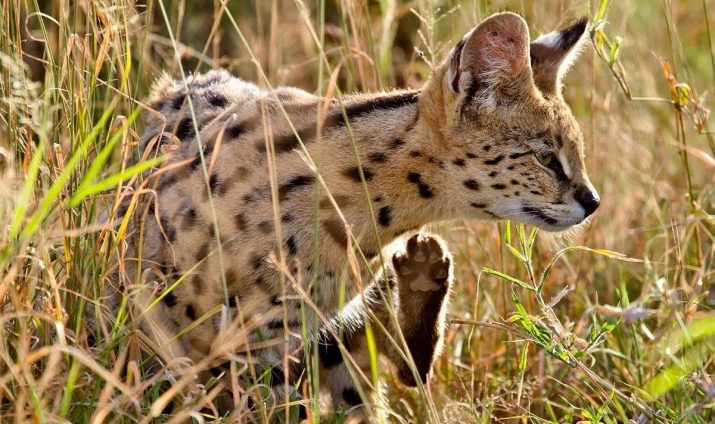
In early spring, the females have offspring. In one litter can be no more than 3 kittens. The gestation period is about 60 days.
Up to 6 months, kittens are completely fed by milk, at six months of age, a cat can teach cubs to hunt and eat on their own, and at 7 months, kittens become independent inhabitants of Africa.
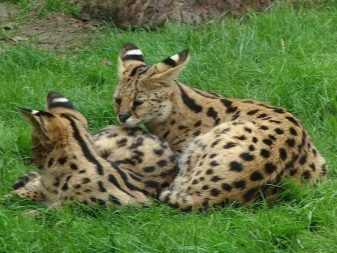
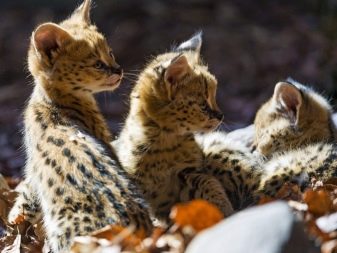
Character Features
Despite the long-term maintenance in an apartment, a domesticated African cat has retained the features of wild ancestors. Animals do not like excessive attention to themselves, most of the time they prefer to be alone. In a period of increased activity, animals love to run, play and jump to a height of more than 2.5 m.
Fragile and valuable objects should not be in the zone of movement of cats. These features must be considered before acquiring a serval.
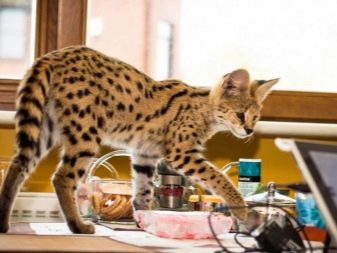

Experts recommend purchasing kittens from verified breeders whose age does not exceed 5 months. Buying older cats is inappropriate due to the inability to tame already formed individuals. The presence of permits is the key to the acquisition of a purebred animal.
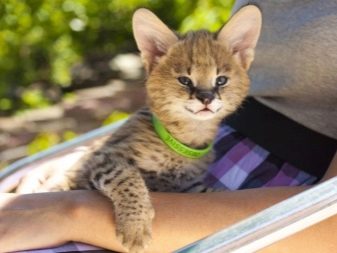
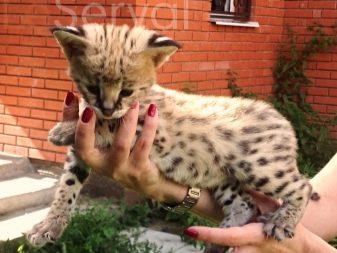
Despite his wild temper, the pet is very friendly and curious. The animal is not only a home decoration, but also a reliable guard who, even during the rest period, keeps order on his territory. In order for the pet to quickly get used to the owners, it must be regularly fed from the hands and played on an equal footing with the beast. The list of prohibited actions:
- game with the hands and feet of the owner;
- scream
- physical punishment.
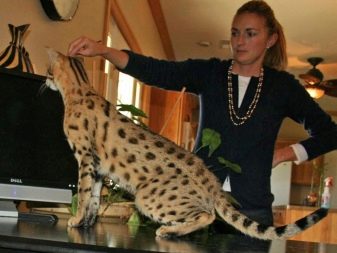
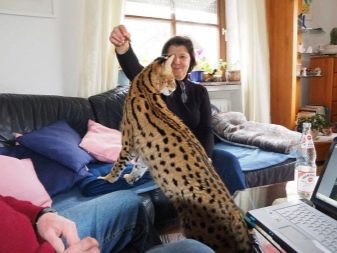
The animal has a good memory, high intelligence and touchiness. If aggressive actions were committed in his direction, the pet will never forgive this and, if necessary, will take revenge on the owner.
A more effective punishment is loneliness, during which the cat independently realizes its mistakes and comes to apologize.
The beast must be protected from communication with young children who can offend him and provoke aggression. If a conflict occurs, the African cat will try to avoid physical contact with the opponent and simply step aside. The main task of the owner of the cat is to show the animal who is the boss in the house and build relationships based on trust, understanding and friendship.
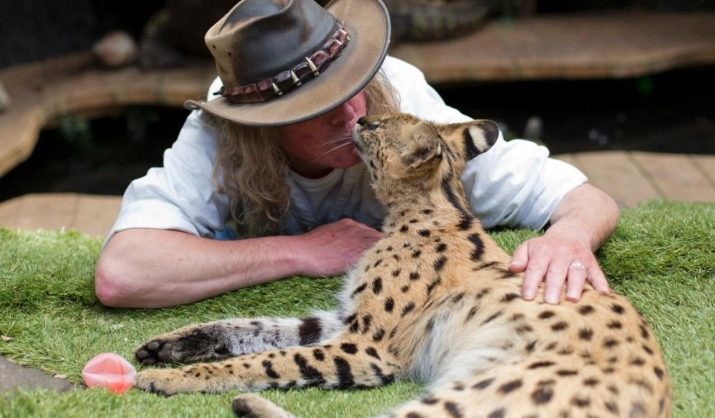
Color options
The classic color scheme of an African cat ranges from light beige to burgundy. Kenyan breeds can also have black fur color. Subspecies that live in forests are more saturated in colors than those that hide in the bushes.
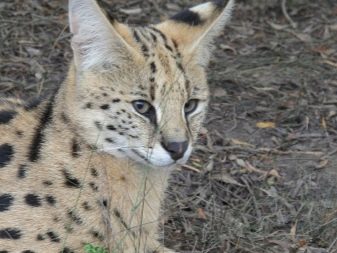
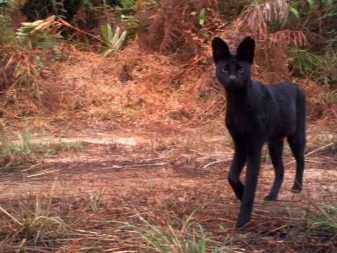
On the fur of most animals you can see black spots that turn into even lines on the back. Sometimes you can observe stripes instead of black spots. The hair on the tail is covered with a circular pattern, and at the end there is always a black brush. Often in a zoo, white kittens with gray spots may be born.
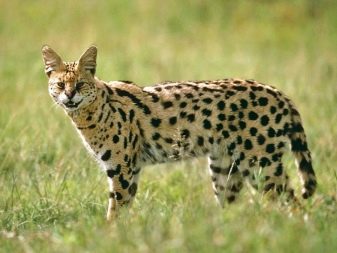
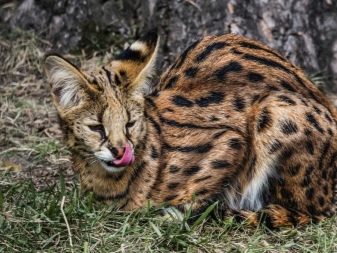
Conditions of detention
Maintenance in the apartment of the serval is a great responsibility and complexity. Without creating comfortable and safe living conditions, it is strictly forbidden to keep an animal in the house. Pet activity peaks in early morning and late evening. After a few hours of active life, the pets get tired and go into the resting phase. A predatory pet must be isolated from other domestic animals, which can become easy prey for a serval.
The pet can cause considerable harm to expensive furniture, wires, paintings and other interior items that will be bitten, labeled and nibbled. To prevent damage to the interior, experts recommend purchasing special toys for cats and dogs, with which the serval will be occupied during the period of activity.
Experienced breeders recommend lubricating the cat's spotlight with apple juice, which will scare away the predator.
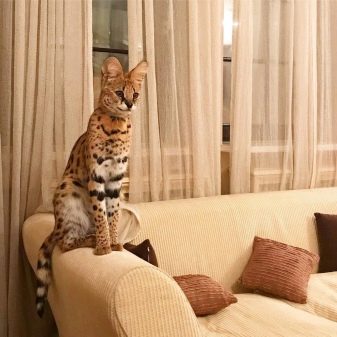
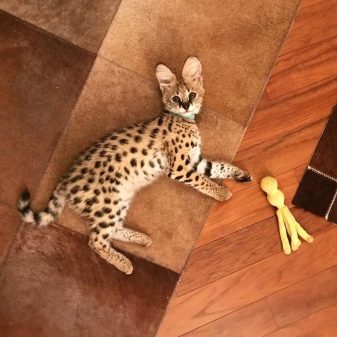
A characteristic feature of the behavior of a home serval is to mark its territory. An animal can perform this procedure up to 40 times per hour. The excreted liquid has a specific unpleasant aroma, which may disappoint the owners. If the cat moves freely around the apartment, and the owners do not plan to obtain offspring, it is necessary to castrate.
Females are sterilized at the age of 12 months, and males - at the age of 8 months.
Young kittens quickly get used to the tray and enjoy using it for the toilet. Serval has a positive attitude to regular water procedures, which will help to avoid the appearance of an unpleasant odor. In the absence of a pet’s desire to swim, it is strictly forbidden to force him. Coercion to something necessarily provoke negativity and aggression.
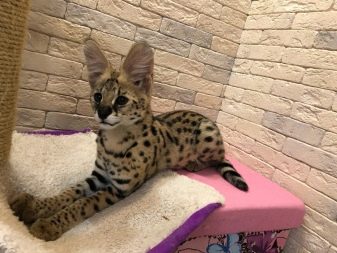

Veterinarians recommend combing your hair and cleaning your ears once a week.For combing a cat, you need to use a pooderka, a fur coat finisher, a rubber brush and a thick comb. The list of daily hygiene procedures:
- teeth cleaning;
- rubbing the eyes with a special lotion;
- claw length adjustment.
Serval responds positively to daily street walks on a leash in the summer. In winter and during the autumn and spring cold weather, the pet's stay on the street should be reduced to a minimum. The animal does not tolerate drafts, strong streams of cold air and sudden changes in temperature. Even when creating the most comfortable living conditions, servals may not please the owners with offspring.
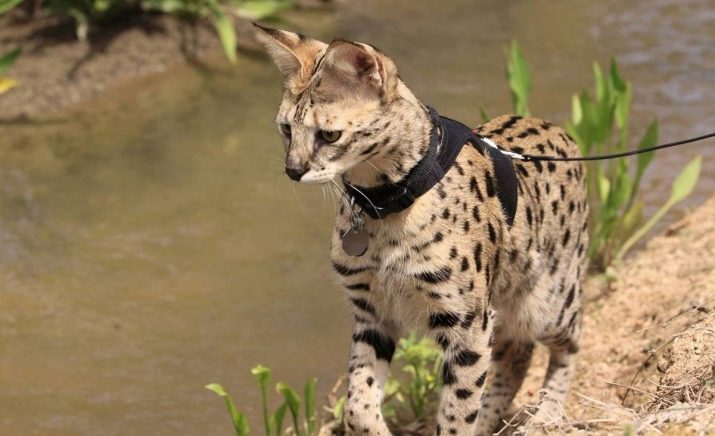
Feeding
The diet of African animals has significant differences from the traditional food of ordinary cats. For the full growth and development of the serval, its menu should consist of chicken and quail meat, beef and veal, as well as offal. Raw meat can be combined with fresh green leaves, which will have a beneficial effect on intestinal function. These products bring home food system closer to natural.

A complete balanced diet will require large financial costs from the owners of the beast. To provide animals with mineral elements, it is necessary to use special vitamin complexes, as well as special high-quality prepared feeds. A healthy adult animal should consume more than 500 g of raw meat product with bones per day. Quail eggs, fodder mice and frogs can be goodies for your pet.
In order to train the animal can be pampered with dry cat food.

An adult pet needs a single feed, and young kittens should be given 2 times a day. The animal should not have free access to food. Veterinarians recommend that cats give 1 day a month a full hunger strike after a year of life. In the summer, the beast needs constant access to clean fresh water. In the diet of the beast there are practically no vegetables, fruits, root vegetables, milk and sour-milk products.
It is strictly forbidden to use pig meat for feeding, which can provoke the development of paralysis, rabies and infectious meningitis. Veterinarians do not recommend feeding animals cheap granular cat food. It contains no more than 5% of the required 50% protein. Inexpensive mixtures contain dyes, preservatives and flavor enhancers that negatively affect digestion.
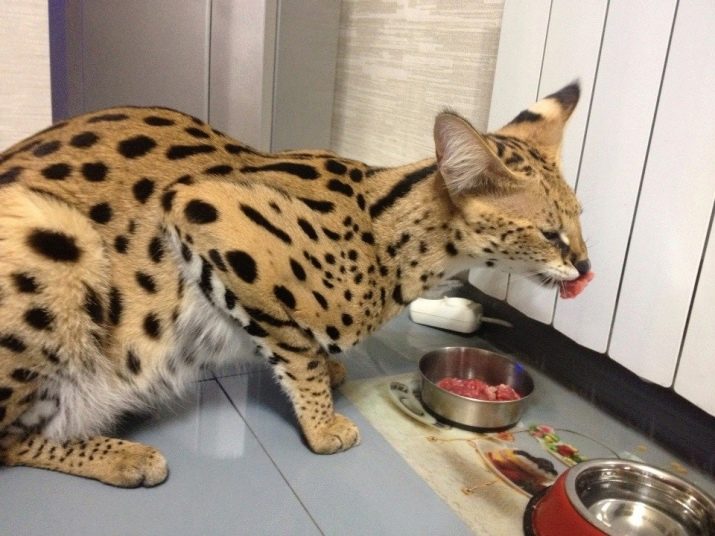
Health
Domestic African beast is distinguished by strong immunity, but needs timely vaccination. Ignoring this procedure can provoke the development of dangerous diseases, and sometimes the death of a pet. Climate change can cause various diseases. A tropical beast does not tolerate frost and temperature fluctuations. The most common diseases are colds and leukemia.
In case of digestive disorders, as well as the appearance of liquid secretions, you must immediately contact a medical institution and not use alternative methods of treatment.
Due to the fragility of the bone skeleton, as well as the unformed form of the limbs in young individuals, it is necessary to limit the number of jumps from above. These games can provoke damage to the paws.
Before acquiring an African kitten, all lovers of exotic animals need to carefully study its nature, diet and living conditions. Serval is not an ordinary domestic cat, this animal even at home remains a predator that needs a special diet, constant attention and a lot of free space. You need to buy small kittens only in well-known nurseries, which can confirm the thoroughbredness of the breed.
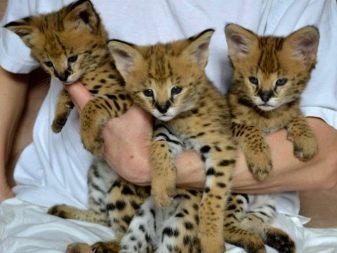

In the absence of financial resources for the maintenance of the cat and a sufficient amount of time for its training and adaptation, it is better not to acquire a wild beast, but to opt for more traditional pets.
You can learn more about the home server from the next video.
